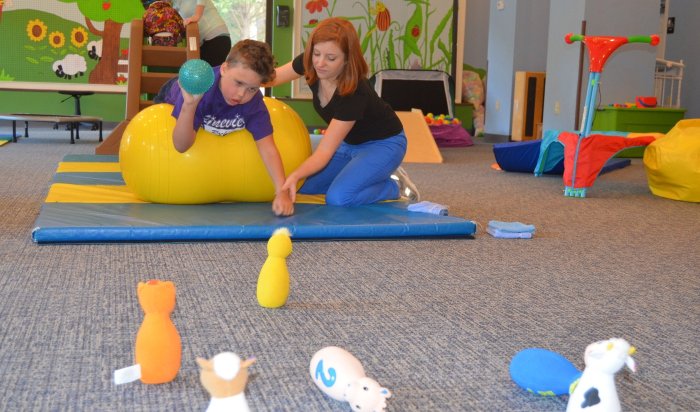Spina bifida and occupational therapy are intertwined in a unique and impactful way, empowering individuals with this condition to navigate daily challenges and achieve optimal well-being. This article delves into the multifaceted role of occupational therapists in supporting individuals with spina bifida, exploring the assessment process, specific interventions, and the profound impact on functional outcomes and quality of life.
Occupational therapists serve as skilled professionals who assess functional abilities, develop individualized treatment plans, and employ specialized techniques to address the unique needs of individuals with spina bifida. Their expertise extends to providing education and training to families and caregivers, ensuring ongoing support and collaboration.
Understanding Spina Bifida
Spina bifida is a birth defect that occurs when the spinal cord doesn’t close all the way during pregnancy. This can cause a variety of physical and developmental problems, depending on the severity of the defect.
Types and Severity Levels
There are three main types of spina bifida:
- Spina bifida occultais the mildest form, in which the spinal cord is closed but there is a small gap in the vertebrae.
- Meningoceleis a more severe form, in which the spinal cord and its coverings (the meninges) protrude through an opening in the vertebrae.
- Myelomeningoceleis the most severe form, in which the spinal cord and meninges protrude through an opening in the vertebrae and are exposed to the outside of the body.
The severity of spina bifida is determined by the location and size of the defect. The higher the defect is on the spine, the more severe the symptoms will be.
Potential Complications and Associated Conditions
Spina bifida can cause a variety of complications, including:
- Paralysis: Spina bifida can cause paralysis in the legs and feet.
- Bowel and bladder problems: Spina bifida can cause difficulty with bowel and bladder control.
- Hydrocephalus: Spina bifida can cause a buildup of fluid in the brain (hydrocephalus).
- Chiari malformation: Spina bifida can cause a condition called Chiari malformation, in which the cerebellum (the part of the brain that controls balance and coordination) is pushed down into the spinal canal.
Spina bifida is also associated with a number of other conditions, including:
- Intellectual disability
- Learning disabilities
- Autism spectrum disorder
- Attention deficit hyperactivity disorder (ADHD)
Occupational Therapy Intervention: Spina Bifida And Occupational Therapy

Occupational therapists play a vital role in supporting individuals with spina bifida. They can help to assess functional abilities, develop treatment plans, and provide specific interventions and techniques to improve daily functioning.
Assessment, Spina bifida and occupational therapy
Occupational therapists use a variety of assessment tools to evaluate functional abilities in individuals with spina bifida. These assessments may include:
- Physical assessment: This assessment includes a review of the individual’s medical history, physical examination, and observation of movement and posture.
- Functional assessment: This assessment evaluates the individual’s ability to perform activities of daily living (ADLs), such as dressing, bathing, eating, and toileting.
- Cognitive assessment: This assessment evaluates the individual’s cognitive skills, such as attention, memory, and problem-solving.
Treatment Planning
Once the occupational therapist has completed the assessment, they will develop a treatment plan that is tailored to the individual’s needs. The treatment plan may include:
- Goals: The goals of the treatment plan should be specific, measurable, achievable, relevant, and time-bound.
- Interventions: The interventions used to achieve the goals may include exercises, activities, and adaptive equipment.
- Evaluation: The occupational therapist will regularly evaluate the individual’s progress and make adjustments to the treatment plan as needed.
Functional Impact

Spina bifida can have a significant impact on daily activities and participation. Individuals with spina bifida may experience challenges with:
- Mobility: Spina bifida can cause paralysis in the legs and feet, which can make it difficult to walk or move around.
- Self-care: Spina bifida can cause difficulty with bowel and bladder control, which can make it difficult to care for oneself.
- Education: Spina bifida can cause intellectual disability and learning disabilities, which can make it difficult to learn and participate in school.
- Employment: Spina bifida can make it difficult to find and keep a job.
Occupational therapists can help individuals with spina bifida to address these challenges and improve their functional outcomes.
Adaptive Equipment and Technology

Adaptive equipment and technology can help individuals with spina bifida to improve their functional abilities and independence. Some common types of adaptive equipment include:
- Wheelchairs: Wheelchairs can provide mobility for individuals who are unable to walk.
- Standing frames: Standing frames can help individuals with spina bifida to stand upright.
- Toilet chairs: Toilet chairs can help individuals with spina bifida to use the toilet independently.
- Assistive technology: Assistive technology can help individuals with spina bifida to perform tasks that they would otherwise be unable to do, such as using a computer or communicating with others.
Occupational therapists can help individuals with spina bifida to choose and use adaptive equipment and technology that meets their individual needs.
Education and Support

Education and support are essential for individuals with spina bifida and their families. Occupational therapists can provide education on spina bifida, its impact on daily functioning, and available resources.
Occupational therapists can also help families to develop support networks and coping mechanisms. Support groups can provide individuals with spina bifida and their families with a sense of community and belonging.
Case Studies
Case studies provide real-world examples of how occupational therapy can help individuals with spina bifida. Here are two case studies:
Case Study 1
A 10-year-old boy with spina bifida was having difficulty walking. He was using a walker, but he was still falling frequently. The occupational therapist worked with the boy to develop a strengthening program and to teach him how to use a wheelchair.
The boy’s walking improved significantly, and he was able to walk without falling. He was also able to use the wheelchair independently, which gave him more freedom and independence.
Case Study 2
A 25-year-old woman with spina bifida was having difficulty finding and keeping a job. She had a college degree, but she was unable to find a job that she could physically perform. The occupational therapist worked with the woman to develop a job search strategy and to identify potential employers.
The woman was able to find a job that she was able to perform, and she has been working there for over two years.
Detailed FAQs
What is the role of occupational therapy in spina bifida?
Occupational therapists assess functional abilities, develop treatment plans, and provide specialized interventions to enhance independence and quality of life for individuals with spina bifida.
How can occupational therapy address the challenges of spina bifida?
Occupational therapists utilize various techniques, such as adaptive equipment, activity modification, and compensatory strategies, to address the functional challenges associated with spina bifida.
What are the benefits of occupational therapy for individuals with spina bifida?
Occupational therapy empowers individuals with spina bifida to participate in meaningful activities, improve their self-care abilities, and enhance their overall well-being.